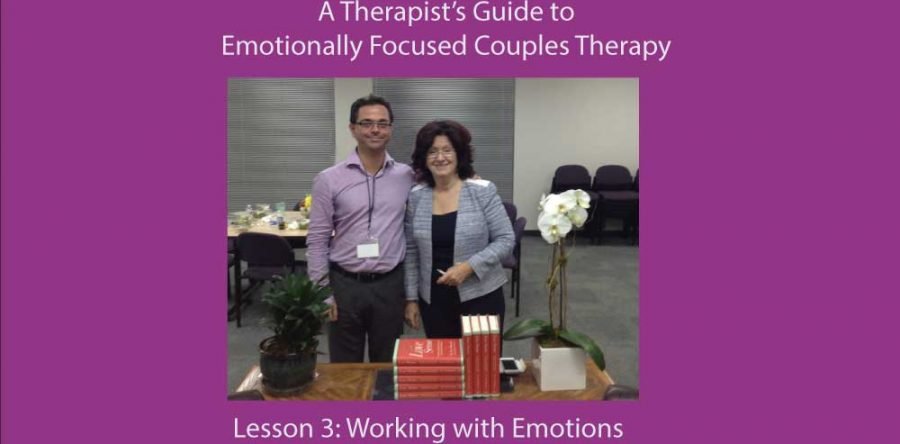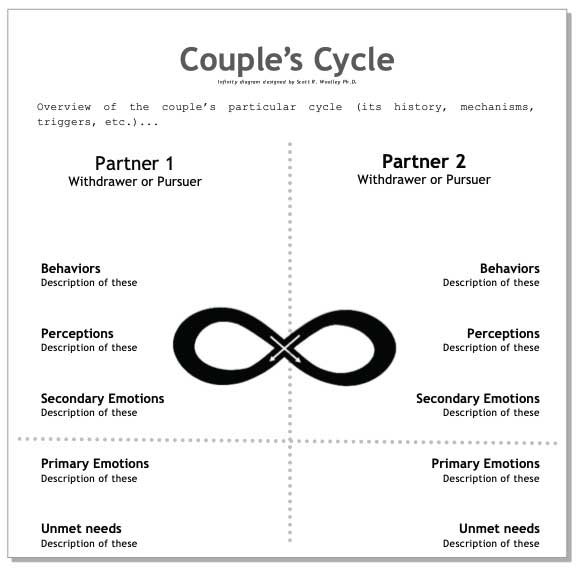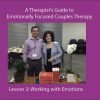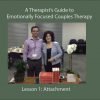Tracking Negative Cycles and Working with Emotions in EFT
In today's lesson we will be looking at how the emotionally focused couples therapist helps couples through step 1-4 of the therapy process. This process involves identifying negative cycles and understanding how they are generated. Once this understanding has been accomplished couples are helped to expand their awareness of unacknowledged and more vulnerable feelings which are not currently being communicated. This awareness then allows new input and communication that can change the negative cycle and help couples interact vulnerably rather than reactively. The key to accomplishing this change is helping couples to become more aware of their feelings and today's lesson will provide a roadmap and a set of techniques for accomplishing this.
Lesson 3: What You will Learn in Today's EFT Lesson
- Understanding how to identify and track the steps of a couple's negative cycles
- Understanding the difference between primary and secondary emotions
- Understanding how to validate secondary emotions while facilitating greater awareness of primary emotions
- Understanding how to work with emotions in stage 1 of EFT
Tracking Negative Cycles in EFT:
A fundamental skill for an EFT therapist is to be able to track and delineate the steps in a particular couple’s negative cycle (as discussed in lesson 1). This involves carefully and empathically helping each partner in a couple slow down and pay attention to what happens inside of them when they get into an argument or get stuck in a stalemate of disconnection. Using Scott Wooley's infinity cycle, the therapist will help each partner understand the links between the following components of their own experience:
Cue: The cue in the other’s behavior which triggered an emotional reaction in them
Attachment meaning: The attachment meaning of this cue
Primary emotion: The primary and more vulnerable feelings they briefly felt but quickly suppressed
Secondary emotion: The secondary emotional reactions to the primary feelings they felt
Perception: What they told themselves when their partner emitted a certain cue
Behavior: And how they responded as a result of how they were feeling and what they told themselves
Scott Wooley's Infinity Cycle:
Primary and Secondary Emotions:
EFT distinguishes between primary emotion and secondary emotion. Primary emotions are the first feelings a person is having in response to what is happening around them. Secondary emotions are emotions that are evoked in response to the initial feeling. For example: My partner might tell me they are disappointed in me which could evoke the primary emotion of sadness, the sting of rejection, or the fear of inadequacy. However, instead of staying in these quite vulnerable emotions, a secondary or more protective emotion might take over such as anger at my partner for rejecting me, making me feel sad, or making me fearful. This angry secondary emotion might evoke thoughts of unfairness, a tendency to blame my partner for being unreasonable, or a desire to reject my partner back by pretending I am indifferent. In emotion focused therapy it is these secondary emotions and the difficulty with staying in and expressing the primary emotions that leads to negative cycles of mutual hurt and distance.
Helping Couples Get in Touch with Their Feelings:
An emotion is an automatic appraisal about how something about a situation either fits or doesn’t fit with what a person is needing or wanting. Emotions are triggered rapidly and automatically using a different and parallel brain circuit than that of cognitive thoughts and intellectual processing. The limbic system processes emotions and make us react even before we know what we are feeling. This is why our body can feel something even without us being able to identify a cause or reason for our feeling. The adaptive function of this rapid automatic appraisal of a situation is that we can act quickly to get out of a situation that is not good for us. For example our body can instinctively react to move away from a snake that can bite us, even before we have intellectually registered that there is a snake on the ground. EFT, in this way, turns the CBT perspective on its head: thoughts do not create emotions, but emotions beget thoughts. From an EFT perspective it is therefore often the case that a person constructs a narrative to make sense of how they feel and that this narrative often can be erroneous. A main focus of EFT is therefore to help partners in a couple pay more attention to their body and be less quick to jump to cognitive conclusions about what they are feeling. A standard EFT intervention is therefore to ask for partners in a couple to slow down and pay attention to what is happening inside or what they are feeling inside.
Using evocative questions such as these, couples are helped to get more in touch with their bodily reactions and feelings...
- What is it like when your partner tells you they are unhappy?
- Where do you feel the sadness?
- What starts to happen inside when you tell yourself she doesn't care?
Questions such as these are invitations to notice and stay with the sensations and inner reactions that arise from within. Without such an explicit invitation to slow down and pay attention these emotions can quickly get pushed away, ignored, or replaced with secondary emotions or reactions. Evocative questions help make room for what would otherwise be but a faint emotional signal. They help the person slow down, be curious about, and make room for this part of their experience which would otherwise remain hidden both to the person and to their partner.
Working with Secondary Emotions in EFT:
Secondary emotions, are emotional responses to the first emotion we are having and are therefore not as deep or as true to our core emotional experience as our primary emotions. I may for example feel angry at my partner for being the cause of my loneliness (sadness), or ashamed of myself for having a need for validation by my partner (attachment reassurance).
The most frequent secondary emotion in couples therapy is anger which frequently covers up underlying hurt, rejection, sadness, or fear. However, anger can also be a primary emotion such as when a person refuses to be abused or asserts a right to have an opinion or to express their feelings. Primary and secondary emotions are therefore best distinguished by asking yourself if the emotion that is currently being expressed is coming from the deepest place within a person, or is a more defensive emotion that covers up the deeper emotion. Typically primary emotions feel more real, authentic, and honest, whereas secondary emotions seem more superficial and less authentic.
However, even if the task of the EFT therapist is to help the partners of a couple get more in touch with their real or most primary feelings, it is important not to invalidate the secondary emotions as a natural and understandable expression of how the person feels in the moment. Since the secondary feeling is often the most consciously available emotion and the one the person most readily identifies with, the therapist must first meet the partners where they are at, and cannot move too quickly into conjecturing about the underlying primary emotion. Only when the critical pursuer feels understood at the level of their frustration and displeasure with their partner’s lack of reactions and engagement, will they be able to acknowledge the sadness and loneliness they feel underneath.
A great video on the topic of working with anger as a secondary emotion is the interview with EFT trainer George Faller on working with Highly Escalated Pursuers. Here he makes the argument that the angry and critical pursuit of more connection and attention is a positive sign that the pursuer is fighting for the relationship, and should not be dismissed or bypassed too quickly. This is a more advanced topic, however, so you might want to come back to the video later, once you have learned more about the general principles of working with emotions.
Working with Negative Cycles in Stage 1 of EFT:
Now that we have established a basic framework for understanding the role of emotions as the fuel or the music of the negative dance or cycle couples do when they are in attachment distress, it is time to learn more about how to work with a couple’s negative cycle.
To get us started, listen to this example from George Faller about the negative cycle he gets into with his wife. It will help you get a better understanding of how to begin to think about connecting the different emotions, actions, and perceptions couples talk about into the bigger picture of their negative cycle.
Working with Emotions in Step 2 of EFT: Tracking Secondary Emotions and Reactions
Step 2 of EFT consists of helping the couple understand the steps of their negative cycle in a preliminary way and to identify each person’s interactional position in the cycle. Although the most predominant pattern is one between a pursuer and a withdrawer, couples can also present as being stuck in a withdraw/withdraw pattern, or an attack-attack pattern. Most often the withdraw/ withdraw pattern is the result of a burned out pursuer who has given up on the pursuit for connection. When this happens, the pursuer might present as a withdrawer, and the withdrawer might temporarily present as the pursuer. Hence, it is not unusual that a couple finally presents for couples therapy when the withdrawer has been scared enough by the pursuer’s withdrawal to get activated to do something about the relationship. All of a sudden the withdrawer wants to try everything that has not been tried to save the relationship, and the pursuer now finally gratified in the way they had wanted, feels like it’s too little, too late. To learn more about identifying and delineating the negative interaction cycle (step 2), read Becoming an Emotionally Focused Therapist in the Practice of Emotionally Focused Couple Therapy: Chapter 4, pp. 128-133
Working with Emotions in Step 3 of EFT: Communicating Primary Emotion
It is important to understand that the EFT method is not about simply promoting a cognitive understanding in each partner of the cycles they are part of. Although step 2 helps couple link their behaviors to each other’s emotional responses, working with each partner in step 3 to bring out the primary emotions and attachment fears that are hidden from view, is essential to making the learning in stage 1 experiential. As Sue Johnson and Les Greenberg comment in their book Emotionally Focused Therapy for Couples, “Step 3 of EFT is the accessing and accepting of unacknowledged feelings underlying interactional positions. This is one of the key steps of treatment; without which significant interactional change will not occur” (p. 88).
The EFT tango (Sue Johnson) is often a useful tool to understand step 3. You zero in on some emotional reaction in one of the partners and help the partner get more in touch with the more vulnerable primary emotion until this emotion is identified and fully articulated. You now need to try to get the person to communicate the more vulnerable emotion to their partner through an enactment, but before you do so they must first feel it so they can communicate from it rather than about it.

In EFT this process of making the primary emotion alive and present is often referred to as bringing the emotion to a boiling point. Only when the emotion is "hot" (felt) and present rather than "cold" (cognitive) and in the past, do you ask the person to turn to their partner and speak what they are feeling.
The purpose of bringing primary emotions to a boiling point is to help one person send a new emotional signal to their partner. It is the emotion more than the content of what is talked about that is important here. The goal is not simply to have one person convey a cognitive understanding of what they are feeling to their partner, but to have their partner be impacted by a more pure and raw expression of what the person is feeling. Their partner must see the feeling in the person's eyes, hear it in their voice, and sense it through their limbic system rather than through the analytical part of their brain.
By sending a new emotional signal to their partner, the partner is likely to respond in a new way as well. When the pursuer is able to get in touch with their loneliness and show their sadness at being apart rather than their frustration about the withdrawer’s lack of engagement, the withdrawer no longer feels attacked and inclined to go away, but now feels compassion and wants to hold and comfort.
As each partner learns to tap into their primary emotions and are helped to send a different emotional signal to the other person, they get to witness that they also get a new response. By changing the emotional music they are playing, they end up changing the nature of their dance.
Working with Emotions in Step 4 of EFT: Seeing the Big Picture and Reframing the Problem
Step 4 in the cycle de-escalation phase of treatment is helping couples fully get the attachment reframe of their negative cycle. Through step 3 they have gotten to experience the hidden dimensions of each other they never saw when they were just attacking the other person or defending themselves. They now need to fully get that they are both fighting to maintain their connection, albeit in different ways, and that the real enemy is the cycle and not the other person.
Although step 4 includes the ability to step back from everything the couple has learned from step 2 and 3 and integrating it into a complete understanding of their cycle, the groundwork for this gets laid by the EFT therapist in a piecemeal fashion through the continuous use of reframes. Reframes help link a partner’s conscious experience of their situation to other elements of the cycle in a way that both suggests a link the partner has not seen and respects their current understanding of the situation. A great article to read on this topic, is EFT trainer Rebecca Jorgensen’s article: Reframing and Step 4 “The Process Reframe”: Using Process Markers to Track De-Escalation
EFT in Action:
Okay, now that you have a good view of the procedures involved in tracking and delineating a couple’s negative cycle, it is time to watch some EFT in action to see what it looks like in actual practice. To get a demonstration of this I recommend that you watch EFT trainer Rebecca Jorgensen’s first EFT session with a couple we will be following through each of the steps and stages. The video is part of 10 session series that follows the couple Carl and Sandra through a completed EFT therapy. The video series is available through the video streaming service Kanopy (Just focus on session 1 for now).
> Click here to watch the video.

Video: Questions/ Things to pay attention to:
- Notice how Rebecca Jorgensen attempts to build rapport by really joining with each partner to help them feel heard. She uses reflections, validation, and lets the couple correct her when her understanding is off. She does not move too quickly into deep interpretations of what is going on, but joins with them at the surface of their currently experienced reality. If she were too move too quickly, or too deeply into the underlying attachment fears at this point, the couple would likely not feel heard and the rapport would suffer. Take-Away #1: Pace Yourself
- Rebecca asks the couple to give an example of something they argue about to begin to assess the nature of the negative cycle the couple is stuck in as well as to identify their interactional positions in the cycle (pursuer vs withdrawer) (step 2). Notice how she does not get stuck with the couple in the content of what they argue about, and does not become a problem-solver or mediator. Instead she zooms out to get a picture of how they argue and what the predictable or recurring pattern is in their dance of disconnection: who does what or says what? Who reacts in what way? Who feels what? How does each person interpret the other’s actions? Try to follow along using Scott Wooley's Infinity Cycle and attempt to begin to lay out the sequence of steps that make up their dance of disconnection. Take-Away #2: Don’t get sucked into the content
- Try to identify who pursues closeness and who withdraws to self-protect in the couple’s negative cycle. Begin to think about what emotions and fears characterize each of these positions based on what you are hearing each partner say. Take-Away #3: pursuers and withdrawers have different emotional realities
- As you watch the video try to keep in mind the basic EFT question: What is the ultimate attachment concern or deepest relationship fear each partner is having? Try to identify ways in which Rebecca Jorgensen reframes the couple’s surface issues in terms of underlying fears or attachment meanings (what language does she use?) Take-Away #4: Try to reframe a couples’ behaviors in terms of attachment fears and longings
- Toward the end of the session (around min 55 + 1h10m) notice how Rebecca is following the steps of the EFT Tango. Refresh your memory of these steps and identify the interventions Rebecca is using. Take-Away #5: Passing on new primary emotions to the partner leads to new learning
- Notice what happens when Sandra takes a risk and communicates her more vulnerable emotions: What is Carl’s response? How does this response break the negative cycle? Take-Away #6: Changing the music, changes the dance
Bonus Video:
If you would like to learn more about the withdrawer and pursuer dynamics that envelop the emotional responses that make a typical negative cycle, I recommend you watch the following interview with EFT trainer Zoya Simakhodskaya. We will revisit this topic in depth in Lesson 5 and 6 when we delve into the psychology of each of these positions:
> Understanding Withdrawers & Pursuers in EFT (29:54)
STAY TUNED FOR THE NEXT LESSON:
In the next lesson of Emotionally Focused Couples Therapy: A Step-By-Step Guide we will explore some more EFT techniques that sets emotionally couples therapy apart from other approaches. In particular we will look at the concept of "enactment" as one of the main ways an EFT therapist will try to facilitate relationship change.






























